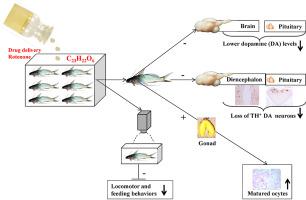Chemosphere ( IF 8.8 ) Pub Date : 2020-09-15 , DOI: 10.1016/j.chemosphere.2020.128355 Muhammad Badruzzaman , Md Shahjahan , Prodip Kumar Roy , Md Taimur Islam

|
Rotenone, commonly used as a pesticide in agriculture and as a piscicide in aquaculture, is a toxic compound that causes dopaminergic neuronal cell loss in the substantia nigra pars compacta of the brain. At the neuroendocrine level, dopamine (DA) drives behavioral (locomotion, emotion, feeding, and social interactions, etc.) and reproductive functions of fish. In the current investigation, we examined effects of rotenone toxicity on neurobehavioral and reproductive functions in whole brain and in selected brain regions in an Indian freshwater catfish, locally known as gulsha (Mystus cavasius). After fish were exposed to water containing rotenone at 0, 2.5, 25, and 250 μg/L for 2 days, significant reductions of DA, 3,4-dihydroxyphenylacetic acid (DOPAC; a DA metabolite), and their ratio (DOPAC/DA) were observed in whole brain at 250 μg/L ambient concentrations of rotenone. When fish were treated with rotenone at 250 μg/L concentration for 2 days, there was a significant reduction of DA, DOPAC and DOPAC/DA in diencephalon, DA and DOPAC in pituitary, and only DA in the telencephalon, compared with control fish. In parallel, numbers of tyrosine hydroxylase-positive (TH+) neurons declined significantly in the diencephalon and pituitary after rotenone treatment. Slowed, spontaneous movement and reduced feeding behavior were observed in rotenone-treated fish. Rotenone treatment resulted in a significantly higher gonadosomatic index with many mature vitellogenic oocytes in ovaries and lowered dopaminergic activity in these fish. These results indicate that rotenone influences neurobehavioral and reproductive functions through dopaminergic neuronal cell loss in gulsha brain.
中文翻译:

鱼藤酮通过脑中多巴胺能神经元的缺乏来改变淡水cat鱼的行为和生殖功能
鱼藤酮通常在农业中用作杀虫剂,在水产养殖中用作杀虫剂,是一种有毒化合物,可导致大脑黑质致密部的多巴胺能神经元细胞丢失。在神经内分泌水平上,多巴胺(DA)驱动鱼的行为(运动,情感,进食和社交互动等)和生殖功能。在当前的调查中,我们研究了鱼藤酮毒性对印度淡水cat鱼(全称为印度长嘴sha(Mystus cavasius)的全脑和部分脑区域的神经行为和生殖功能的影响)。)。鱼在0、2.5、25和250μg/ L的含有鱼藤酮的水中暴露2天后,DA,3,4-二羟基苯基乙酸(DOPAC; DA代谢产物)及其比例(DOPAC / DA)显着降低在全脑中鱼藤酮的环境浓度为250μg/ L时观察到)。与对照鱼相比,当用250μg/ L浓度的鱼藤酮处理鱼2天时,间脑中的DA,DOPAC和DOPAC / DA显着降低,垂体中的DA和DOPAC显着降低,而在远脑中只有DA。同时,酪氨酸羟化酶阳性(TH +鱼藤酮治疗后脑和垂体神经元明显下降。鱼藤酮处理的鱼中观察到缓慢,自发的运动和减少的进食行为。鱼藤酮处理会导致卵巢中许多成熟的卵黄卵母细胞具有明显更高的性腺体指数,并降低这些鱼的多巴胺能活性。这些结果表明,鱼藤酮通过在豚鼠脑中多巴胺能神经元细胞的损失影响神经行为和生殖功能。



























 京公网安备 11010802027423号
京公网安备 11010802027423号